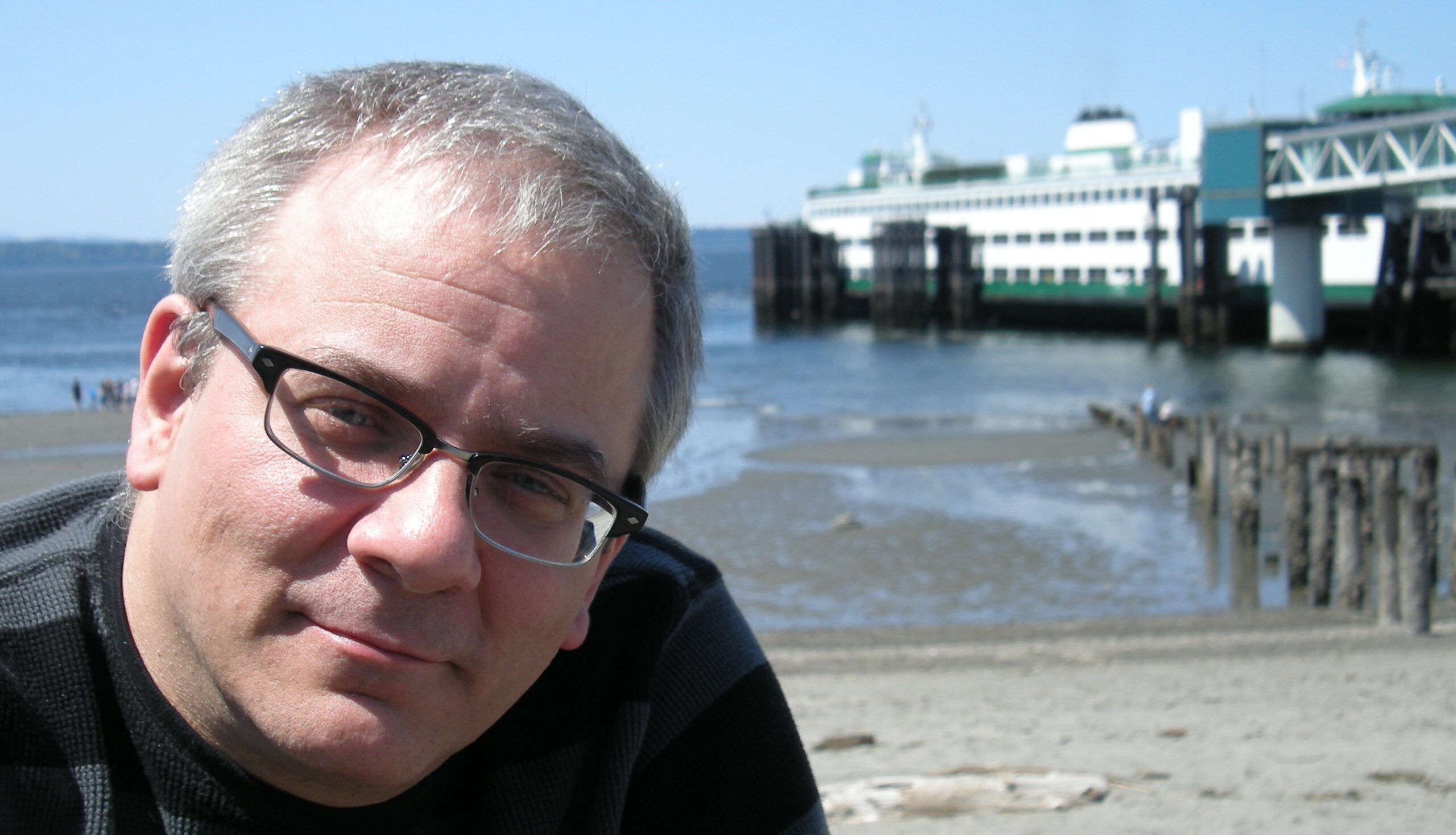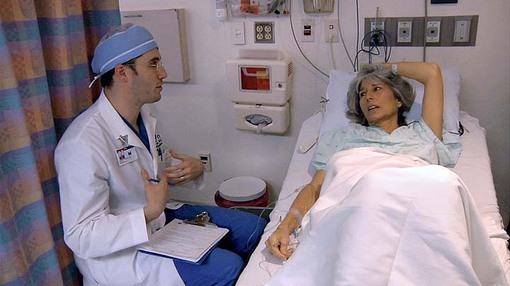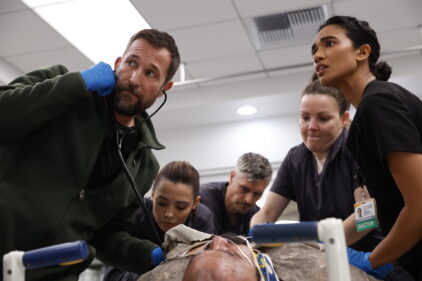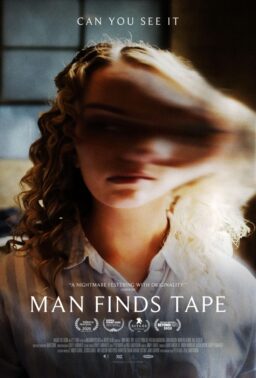“How to Die in Oregon” plays on HBO on May 27, 29 and 31 and June 1 and 6.
Click here for HBO showtimes.
I’ve been encouraged to write autobiographically in this forum, so bear with me, dear reader. We’ve barely been introduced, and this time it’s personal. I’ll be sharing some thoughts about HBO’s extraordinary new documentary “How to Die in Oregon”, but first, allow me this indulgence:
When my father died four months ago at the age of 79, I sat beside him in my wheelchair as his death drew near. I couldn’t hold his hand and he couldn’t hold mine, so I gently touched the parchment-like skin of dad’s withered right arm while my older brother, standing on the other side of the bed, leaned over and quietly suggested to our father that this was “a good time to go.”
Dad must have agreed, because a few seconds later, he did.
He went gently and peacefully after many hours of slow, labored breathing. Only three weeks had passed since he’d been definitively diagnosed with bowel cancer. In a case of fortunate timing, we’d brought him home from the hospital about 30 hours earlier; we knew he preferred to die at home. Apart from the morphine drip we’d been trained to operate by compassionate hospice-care advisors, there were no lethal drugs or physicians involved.
(Above: Jerry and Jeff Shannon, 2009)
By circumstance or design (I can’t say which), just the three of us were together when my dad died, in the intimate condominium dad had shared with our stepmother for many years. My brother had dimmed the low lights lower just a few minutes earlier; he knew that reducing sensory input is a comfort to the dying. The local classical music station had been playing for hours at low volume. I place no particular significance on the fact that that Haydn’s “Surprise” symphony was playing when dad died. It just was.
Dad suffered from severe discomfort before he died, but his pain was well-managed and all of us, including my sister and stepmom, had time to properly say our goodbyes, knowing they’d been heard and acknowledged. I can honestly tell you that my father’s death was profoundly beautiful, and occurred at precisely the right moment, no sooner or later than it should have.
When my mother died from lung cancer in Seattle in 1988, at the far-too-young age of 56, she’d been ravaged for months by a brutal combination of chemotherapy, helplessness and extreme frustration. Six months earlier she’d been told she had six months to live, so at least we all had the comfort of an accurate prediction. I had visited her on the day she died, convinced I’d return before that moment arrived, but early that evening she died peacefully and alone in her hospice room, where a nurse had left her just a moment before. I later learned, to my surprise, that this was by my mother’s request. A small group of family and friends had gathered in a nearby room, and the nurse informed them when mom’s death was confirmed.
For both of my parents, I feel that death came with dignity and respect for the lives they had lived. There’s just once crucial difference: My father’s death was natural, and his decline was not unduly prolonged by extensive (and expensive) palliative care. My mother died naturally, too, but ever since her death I have held firmly to the conviction that she should have died sooner — perhaps as much as two months earlier — and I think she might’ve found that option appealing. In Washington State, in 1988, she didn’t have that option.
As I write this, I am one month shy of my 32nd anniversary as a “PWD” (person with a disability). Clinically speaking, I’m designated “C-5/6 complete quadriplegic,” paralyzed from the upper chest down by a spinal cord injury that occurred on the coast of Maui in the summer of 1979. I was three weeks shy of my 18th birthday, and had graduated from high school two weeks earlier. Accompanied by a group of fellow graduates, my trip to Hawaii was a graduation gift from my parents.

When I was first injured, lying face down in the Maui surf, in shock and on the verge of drowning, I had a genuine near-death experience. I won’t pretend to know what happens when we die, but I’ve been to the threshold and I’ve had a sneak preview. If you want to know what a near-death experience is like, ask a survivor: The details are profoundly similar, suggesting some kind of afterlife that is physically and spiritually universal. If you haven’t already, take another look at Clint Eastwood’s “Hereafter“: Remove the whooshing sound effects, and the near-death experiences depicted in that film are uncannily accurate. Nearly everyone who’s had this experience recalls an overwhelming sense of peace and acceptance, and ever since that day in 1979, I’ve had no fear of dying. My N.D.E. is a gift that keeps on giving.
With the rock-solid support of my devoted parents, I gradually adjusted to life as a “quad,” and for 32 years I’ve made a modest but for the most part comfortable living doing something I love. I’ve lived “A Life In Movies” (to borrow the title of Michael Powell’s autobiography), and by any rational measure it’s been an interesting life, fraught with difficulties but consistently enjoyable and entirely worthwhile.

Then things changed. Beginning in 2009, my paralyzed body started to stage a rebellion. Bladder management is a major factor of living with paralysis; now mine was giving me very serious trouble. I later learned that it’s normal for quads to experience additional difficulties after hitting their 30-year mark. (I wish I’d been warned!) During 2010 alone, I was ambulanced to emergency rooms on ten separate occasions due to autonomic dysreflexia, a complication unique to spinal cord injuries that causes (among other traumatizing symptoms) extreme hypertension — what I like to call “neurological mayhem” — including dangerously high blood pressure that escalated, in my case, to potentially fatal readings of 260/130.
In less than a month, I’d gone from 30 years of near-perfect health to the constant threat of serious setbacks. Medical bills stacked up like junk mail, depleting my savings. After that tenth ER visit, in late September, I told my brother, with absolute sincerity, that I didn’t want to live, if this was what life had in store for me. But after a brief stay in the hospital and additional tests on my overworked heart, I was stabilized by antibiotics, got discharged, and got on with the business of living.
Today I’m living a “new normal” that’s a lot more troublesome than my “old normal.” Like many others in our current economy, I’m in the process of radical downsizing. I’ve made a difficult transition from a manual wheelchair to a motorized one. I urinate through an in-dwelling catheter that’s a constant source of irritation and potentially dangerous bladder infections. I take several medications for pain and muscle spasms, and they all have problematic side effects, with one exception: Marijuana. It’s cheaper and more benignly effective, I’m fully authorized to procure it from a local dispensary, and my light, occasional use allows me to postpone or even skip dosages of the other “legitimate” medications. Its only side effects are a mild buzz and the occasionally irresistible desire to gobble M&M’s while watching “Avatar” on Blu-ray, if only for the eye-candy. (And while I’m certain there’s a portion of that film that syncs up with Pink Floyd’s “Dark Side of the Moon,” I won’t be the guy who goes looking for it. I’ve got better things to do with my time.)
So, you may justifiably ask, why spill my guts as preamble to a discussion of HBO’s “How to Die in Oregon”? It’s simply because I have no doubt that many people reading this will mistakenly conclude that “It must really suck to be you.” (I might agree on bad days; mostly I won’t.) Some may even feel that I’m “better off dead,” another mistaken assumption that caused many disability activists to protest against Eastwood’s “Million Dollar Baby,” which ends (spoiler alert!) with a newly-injured quadriplegic’s hoped-for euthanasia. (For the record: While it may be true that suicide rates are statistically higher among people with spinal cord injuries, paralysis is never the single contributing factor in their ultimate decision.)
More importantly, I’ve shared these personal details because my life experience — and my near-death experience — have convinced me that I want to exercise control over how my life ends. I want to be the one who determines when “my time” has come, even if that means dying naturally or, as some might prefer to phrase it, “letting go and letting God.” I may not have a terminal illness now or later — and I think it’s appropriate that non-terminal paralysis legally disqualifies me from the option of “physician-assisted suicide” — but I’ll know when my “quality of life” has reached its lowest ebb. I’ve almost been there already, so I’ll know, with absolute certainty, when I’ve truly reached that limit. I won’t allow anyone else to determine what “that limit” is, but if I knew I was spiraling downward with no chance of improvement, would a few more days, weeks or months make any kind of difference?
I know these comments will be hotly opposed in some religious, political and even disability-related circles, but it’s for that very reason that “How to Die in Oregon” will likely be viewed, in retrospect, as one of the most historically significant documentaries of this still-young decade. “Must-see” is an over-used phrase in movie reviews, but “How to Die in Oregon” truly is a film that everyone (even and perhaps especially younger viewers, with parental supervision) should see, ponder, and openly discuss.
It is a challenging yet beautiful film that many will start watching and not want to finish. It won the Grand Jury Prize for Best Documentary at Sundance this year, and it deserves the same massive audience that flocked to theaters to see “An Inconvenient Truth,” because it addresses an equally inconvenient truth: We — and by that I mean all of humanity — need to examine death and dying with our minds wide open.
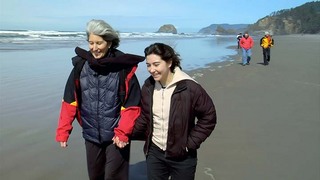
We need to reconcile “death with dignity” with the poorly-worded, arguably inaccurate phrase “physician-assisted suicide,” and that puts all of us in the same position we faced during the fight for abortion rights. This is not an issue that will ever be resolved in our collective hearts and minds; it will only be legislated according to majority vote. But there’s no doubt in my mind — and in the minds of those who made and participated in “How to Die in Oregon” — that Oregon (and now Washington, where I live) will not be the only states to vote upon and pass legislation on this deeply contentious issue.
Here’s how it works, as dictated by law in Oregon since 1994 (following precedents set by Switzerland and the Netherlands): Wanna-be Kevorkians need not apply. Lethal injections are strictly forbidden. If you have chosen the time of your death, it’s because you’ve been officially diagnosed with a terminal condition and given six months or less to live. You’ve stated your preference for self-determined death in writing, on an official form signed by you, your physician, and two witnesses of your choosing. You’ve been given a prescription (covered by insurance) for Nembutal or Seconal (for what it’s worth, the latter costs less), and you have total freedom of choice regarding when — or whether — to ingest the lethal cocktail mixed from one (not both) of those ingredients.
You’ll have all the time you need to put your affairs in order exactly as you desire. If your condition declines to a point of no return, you can then definitively schedule your “time to go.” If you cannot lift and swallow the lethal cocktail independently and of your own volition (it’s foul-tasting, so a pleasant chaser is recommended), nobody is allowed to legally assist you, in which case you’ll die when “natural causes” take you.
A physician needn’t be present to preparing the cocktail or provide moral support; friends and family can be assigned to those tasks, should they choose to participate. The cocktail induces a coma within minutes. Death follows shortly thereafter.
We understand nearly all of this from the pre-credit sequence of “How to Die in Oregon,” and as the film progresses we’ll understand many of the delicate details surrounding the procedure. I won’t spoil that sequence here; you will either find it profoundly beautiful (as my father’s death was) or you’ll be inclined to stop watching (my advice: don’t). This is not a film — or an issue — that provides any kind of middle-ground.

It should be noted up front that Peter D. Richardson — the writer, director and photographer of this film — never hides where his sympathies lie. “How to Die in Oregon” is fair in presenting its philosophical stance, but it’s not exactly balanced. We hear from an opposing physician with a literal-minded defense of the Hippocratic Oath, and we see anti-assisted-suicide protestors on the capitol steps of Olympia, Washington, when the issue (known here as Initiative 1000) came up for a vote in 2008. We also visit an outraged blue-collar Oregonian named Randy Stroup, who is denied coverage for chemotherapy in an official letter that lists doctor-assisted “end-of-life” as one of his remaining options. “The guy who wrote this letter,” says Stroup in disgust, “should be sent to prison for life.”
Richardson isn’t merely paying lip-service to opposing views, but their screen-time is comparably brief. In a film with many talking-head interviews, he provides historical context by including Derek Humphry, founder of the Hemlock Society and author of the suicide guidebook “Final Exit,” but he fails to interview leaders from groups like Not Dead Yet, who feel that death-with-dignity legislation could potentially lead to the rise of eugenics and the further devaluing and prematurely-encouraged death of the sick, disabled, or anyone else perceived as a burden to society. (You could argue that the no-Kevorkian policy trumps their concerns, but that’s just another debate that this issue provokes.)
Instead, “How to Die in Oregon” does what any film must do to engage the viewer: It tells us compelling stories about what it means to be human. Richardson shows us the kind of intimate dramas that unfold thousands of times every day around the world, experienced by everyone, eventually, but rarely discussed in public, much less on film or TV — mediums that frequently trivialize death while avoiding its place in our daily existence.
And so it is that we meet interesting, likeable families and individuals in Oregon who (like 500 Oregonians to date) have taken advantage of state law to play out their own end-of-life scenarios. People like Ray Carnay, a velvet-voiced, 84-year old baritone with throat cancer who, after a lifetime in broadcasting, records his own self-written eulogy. He refused to have his voice-box removed as a treatment option, and it brings him great satisfaction to know that his carefully considered words (and their dulcet-toned delivery) will comfort mourners at his funeral.
We also meet Nancy Niedzielski, a widow in Seattle. She’s the sensible spearhead of I-1000, prompted into action after her husband Randy suffered through the debilitating humiliation of inoperable brain and spinal cord cancer. Randy’s dying wish was for Nancy to promote death-with-dignity in Washington, and as Nancy notes with sad yet forceful determination, her marriage and her mourning won’t end until Randy’s wish is granted. (It was, by a 59-to-41 percent margin.)

Most of all, “How to Die in Oregon” tells the story of Cody Curtis, a regally dignified, silver-haired 54-year-old wife and mother of two young-adult children, who is riding a roller-coaster of emotions after being diagnosed with liver cancer and given six months to live. She outlives that diagnosis and benefits from palliative treatment (thus crucially demonstrating the parameters of Oregon’s law), but it’s a temporary reprieve from the inevitable.
Cody is — was — a brave and beautiful woman in every sense of the word. We come to know her well, in part because her final months, weeks, and days unfold with familial emotions at peak intensity. Her bravery extends to her acceptance of Richardson’s camera, but there’s no reality-TV exploitation happening here. It is our privilege to be sharing most (but not all) of Cody’s end-of-life experience. When her time comes, as planned by Cody and carried out with the loving participation of her surgeon and family, Richardson takes his camera discreetly outside on that chilly winter evening. Silhouettes move behind the curtained window of Cody’s bedroom, and we hear the words being spoken inside.
What you won’t see or hear in “How to Die in Oregon” is anyone’s actual death. Richardson knows that some privacy must never be violated.
I watched “How to Die in Oregon” twice, both viewings intensely informed and influenced by my own experience, my own life and my own opinions about how I prefer to see it end. As a quadriplegic faced with new and serious challenges, I don’t feel threatened by Richardson’s film because I’m not afraid of dying. I’ve never felt that I was “better off dead,” and because I haven’t “reached my limit,” I have no desire, legally or otherwise, to hasten my demise. To these eyes and ears, there’s nothing in “How to Die in Oregon” — or in Oregon’s law — that suggests that I should do so.
Death is a bridge we all must cross. How we choose to approach that bridge, and at what pace, is what this film is ultimately about. If that frightens you or threatens your delicate sensibility, then watching this film with an open mind becomes even more important.“How to Die in Oregon” premieres today (May 26) on HBO, with additional playdates on May 29th and June 4th, and on HBO-2 May 31st, June 1st and 14th. On-demand access on HBO-GO is presently TBD.

A Seattle-based freelancer, Jeff Shannon has been writing about film and filmmakers since 1985, for the Seattle Post-Intelligencer (1985-92) and The Seattle Times (1992-present). He was the assistant editor of Microsoft’s “Cinemania” CD-ROM and website (1992-98), where he worked with rogerebert.com editor Jim Emerson, and was an original member of the DVD & Video editorial staff at Amazon.com (1998-2001). Disabled by a spinal cord injury since 1979 (C-5/6 quadriplegia), he occasionally contributes disability-related articles to New Mobility magazine, and is presently serving his second term on the Washington State Governor’s Committee on Disability Issues and Employment.
